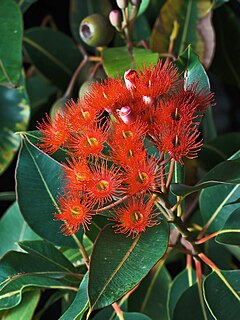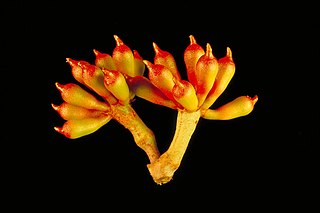
Corymbia ficifolia, commonly known as the red flowering gum, is a species of small tree that is endemic to the south-west of Western Australia. It has rough, fibrous bark on the trunk and branches, egg-shaped to broadly lance-shape adult leaves, flower buds in groups of seven, bright red, pink or orange flowers and urn-shaped fruit. It has a restricted distribution in the wild but is one of the most commonly planted ornamental eucalypts.

Corymbia citriodora, commonly known as lemon-scented gum or spotted gum, is a species of tall tree that is endemic to north-eastern Australia. It has smooth white to pink bark, narrow lance-shaped to curved adult leaves, flower buds in groups of three, white flowers and urn-shaped or barrel-shaped fruit.

Corymbia aparrerinja, commonly known as ghost gum, is a species of tree that is endemic to Central Australia. It has smooth bark, lance-shaped or curved adult leaves, flower buds in groups of three or seven, white flowers and cup-shaped to cylindrical fruit.

Corymbia dallachiana commonly known as Dallachy's ghost gum or Dallachy's gum, is a species of tree that is endemic to Queensland. It has smooth bark, lance-shaped or curved adult leaves, flower buds usually in groups of three, white flowers and cup-shaped, cylindrical or barrel-shaped fruit.

Corymbia terminalis, also known as tjuta, joolta, bloodwood, desert bloodwood, plains bloodwood, northern bloodwood, western bloodwood or the inland bloodwood, is a species of small to medium-sized tree, rarely a mallee that is endemic to Australia. It has rough, tessellated bark on some or all of the trunk, sometimes also on the larger branches, smooth white to cream-coloured bark above, lance-shaped adult leaves, flower buds in groups of seven, white flowers and urn-shaped fruit.

Corymbia henryi, commonly known as the large-leaved spotted gum, is a species of small to medium-sized tree that is endemic to north-eastern Australia. It has smooth, mottled bark, lance-shaped adult leaves, flower buds in groups of three, white or lemon yellow flowers and barrel-shaped to urn-shaped fruit.

Corymbia trachyphloia, commonly known as the brown bloodwood, is a species of small to medium-sized tree that is endemic to eastern Australia. It has rough, tessellated bark on the trunk, often also on the larger branches, lance-shaped adult leaves, flower buds in groups of seven, white flowers and urn-shaped fruit.
Corymbia hendersonii, commonly known as Henderson's bloodwood, is a species of tree that is endemic to Queensland. It has rough, tessellated bark on the trunk and branches, lance-shaped adult leaves, flower buds in groups of seven, creamy white flowers and urn-shaped to barrel-shaped fruit.

Corymbia zygophylla, commonly known as the Broome bloodwood, is a species of small tree or a mallee that is endemic to Western Australia. It has rough, tessellated to fibrous bark on the trunk and branches, a crown of juvenile heart-shaped to lance-shaped, stem-clasping leaves, flower buds in groups of three or seven, white flowers and urn-shaped to shortened spherical fruit.
Corymbia aureola, commonly known as yellowjacket or yellow bloodwood, is a species of tree that is endemic to Queensland. It has rough bark on the trunk and larger branches, lance-shaped to curved adult leaves, flower buds in groups of seven and barrel-shaped, urn-shaped or cylindrical fruit.

Corymbia bleeseri, commonly known as the glossy-leaved bloodwood or the smooth-stemmed bloodwood, is a species of tree that is endemic to northern Australia. It has thin, rough bark on part or all of the trunk, smooth bark above, lance-shaped to curved adult leaves, flower buds in groups of seven, creamy white flowers and barrel-shaped fruit.

Corymbia dichromophloia, commonly known as the small-fruited bloodwood, variably-barked bloodwood or gum-topped bloodwood, is a species of tree that is endemic to northern Australia. It has smooth white bark sometimes with flaky bark on the trunk, lance-shaped adult leaves, flower buds usually in groups of seven, creamy white flowers and urn-shaped fruit.

Corymbia erythrophloia, commonly known as the red bloodwood, variable-barked bloodwood, red-barked bloodwood or gum-topped bloodwood, is a species of tree that is endemic to Queensland. It has rough bark on the trunk and branches, egg-shaped or lance-shaped adult leaves, flower buds in groups of seven, creamy white flowers and urn-shaped to spherical fruit.
Corymbia lamprophylla, commonly known as the shiny-leaved bloodwood, is a species of tree that is endemic to central Queensland. It has rough, tessellated bark on the trunk and larger branches, lance-shaped adult leaves, flower buds in groups of seven, creamy white flowers and urn-shaped fruit.
Corymbia rhodops, commonly known as the red-throated bloodwood, is a species of tree that is endemic to Queensland. It has rough, tessellated bark on the trunk and larger branches, lance-shaped adult leaves, flower buds in groups of seven, creamy white flowers with a red centre, and urn-shaped to barrel-shaped fruit.

Corymbia setosa, commonly known as the rough leaved bloodwood or desert bloodwood, is a species of small tree that is endemic to north-eastern Australia. It has rough, tessellated brown bark on the trunk and branches, a crown of juvenile, heart-shaped leaves arranged in opposite pairs, flower buds in groups of three or seven, white flowers and urn-shaped to shortened spherical fruit.
Corymbia stockeri, commonly known as the blotchy bloodwood, is a species of small tree that is endemic to Cape York Peninsula in Queensland. It has rough, tessellated bark on the trunk and branches, lance-shaped adult leaves, flower buds in groups of seven, creamy white flowers and barrel-shaped to urn-shaped fruit.

Corymbia torelliana, commonly known as cadaghi or cadaga, is a species of tree that is endemic to north Queensland. It has smooth, greenish grey to white bark, rough at the base of older trees, egg-shaped, heart-shaped or lance-shaped adult leaves, flower buds in groups of three or seven, white flowers and urn-shaped or shortened spherical fruit.

Corymbia watsoniana, commonly known as the large-fruited yellowjacket, is a species of tree that is endemic to Queensland. It has rough, tessellated bark on the trunk and branches, egg-shaped to broadly lance-shaped adult leaves, flower buds in groups of seven, creamy white flowers and barrel-shaped or urn-shaped fruit.
Corymbia xanthope, commonly known as Glen Geddes bloodwood, is a species of tree that is endemic to a small area of Queensland. It has thick, rough bark on the trunk and branches with yellow bark visible underneath, lance-shaped to curved adult leaves, flower buds in groups of seven, creamy white flowers and urn-shaped fruit.














